Boating Rules and Regulations
Prohibited Operations:
- Operating a vessel or personal watercraft under the age of 12. Must be 14 years old and have a vessel license to operate a vessel or personal watercraft alone.
- Operating a vessel in such a manner and at a rate of speed as will create a hazardous wash or wake when approaching or passing another vessel or when entering or leaving a harbor or marina area.
- No person, except in jump buoys and like objects used normally in competitive and recreational skiing, shall operate or manipulate any vessel, tow rope, or other device by which the direction or location of water skis, aquaplane, or similar device may be affected or controlled in such a way as to cause the water skis, aquaplane, or similar device or any person thereon to collide with or strike any object or person.
- Operating a vessel towing a person or persons on water skis, or an aquaplane or similar device unless there is in the vessel a person, in addition to the operator who is at least 12 years of age and is observing and is capable of communicating to the operator the progress of the person being towed or unless the vessel is equipped with a wide-angle mirror with a viewing surface of at least 500 sq. centimeters (78 square inches) and a field of vision of at least a 170 degrees.
- Operating a vessel above plane speed when persons or equipment are positioned in a manner that would obstruct the operator's view or impair the safe operation of the vessel. (Sailboats are exempt from this section)
- Operating a vessel in violation of any established speed zone.
- Operating a vessel after April 28, 1999, which violates federal laws regulating the horsepower of the engine of the vessel.
- The exhaust of every internal combustion engine used on any vessel shall be effectively muffled by equipment so constructed and used as to muffle the noise of the exhaust in a reasonable manner. It is unlawful for any person to operate or give permission to operate any vessel powered by an engine or outboard motor in such a manner as to exceed a noise level of 86 decibels measured at a minimum distance of 15.2 meters (50 feet) from the vessel. The use of cutouts is prohibited, except for vessels competing in a regatta or official boat race, and for such vessels while on trial runs.
- Sponsoring a regatta, race, marine parade, tournament, trial runs, or exhibition without providing adequate protection from marine traffic, interference and hazards and obtaining a permit at least 15 days prior to the event.
- No person shall operate or give permission to operate any vessel on the waters of this state towing a person or persons on water skis, surfboard, spinners, or other similar devices unless such person or persons being towed are wearing a U.S. Coast Guard-approved wearable "Performance Level" PFD approved for the specific activity an older style Type I, II, III, or Type V U.S. Coast Guard-approved PFD which is in good, serviceable condition and is approved for the specific activity.
- Operating or giving permission for the operation of any vessel unless the vessel is currently registered and numbered in accordance with laws and regulations.
- No person shall operate any vessel on the waters of this state within 244 meters (800 feet) below a hydro-electric dam and/or navigational lock and dam unless each person aboard, including the operator, is wearing a U.S. Coast Guard-approved wearable PFD utilizing the appropriate "Performance Level" or the older style Type I, II, III or V PFD, which is in good, serviceable condition and is approved for the specific activity.
- Wearable PFDs will be worn and securely fastened in accordance with the manufacturer's instructions and recommendations for such PFDs.
- No vessel shall be loaded with passengers or cargo beyond its safe carrying capacity, taking into consideration weather and existing operating conditions.
- No person, except in an emergency, shall moor to or interfere with destroy, submerge, climb upon, damage, move, or cause to be removed from its mooring, any regulatory signs, markers, or aids to navigation.
- No person shall operate or give permission for the operation of a vessel which is not equipped with safety equipment required by law.
Boating Under the Influence
No person shall drive or be in actual physical control of a vessel or manipulate any water skis, aquaplane, or any other marine transportation device while:
- there is 0.08% or more by weight of alcohol in the blood.
- under the influence of alcohol.
- under the influence of a controlled substance.
- under the combined influence of alcohol and a controlled substance.
- under the influence of any substance that impairs the mental or physical faculties of the person.
Refusal to submit to a field breath test or other approved testing shall result in the same punishment as provided for operators of motor vehicles on the state highways (automatic suspension of vessel license).
Water Traffic "Rules of the Road" in the State of Alabama
- Vessels passing head-on shall keep to the right.
- Vessels overtaking another vessel may do so on either side but must grant the right-of-way to the vessel being overtaken.
- When vessels are passing at right angles, the vessel on the left will yield the right-of-way to vessel on the right.
- Motorboats shall yield the right-of-way to non-motor powered boats except as follows:
- When being overtaken by non-powered vessels.
- Deep draft vessels must remain in narrow channels.
- When a vessel is towing another vessel.
- Motorboats must maintain a direct course when passing sailboats.
- Any vessel approaching a landing dock or pier shall yield the right-of-way to any departing vessel.
- Any vessel departing the shoreline or tributary shall yield the right-of-way to through traffic and vessels approaching the shoreline or tributary.
- Vessels will not abruptly change course without first determining that it can be safely done without risk of collision with another vessel.
- If an operator fails to fully understand the course of an approaching vessel, he must slow down immediately to a speed barely sufficient for steerageway until the other vessel has passed.
- Vessels yielding right-of-way shall reduce speed, stop, reverse, or alter course to avoid a collision. Vessels with right-of-way shall hold course and speed. If there is danger of collision, all vessels will slow down, stop, or reverse until danger is averted.
- Vessels will issue warning signals in fog or thick weather.
- No mechanically propelled vessel shall be operated in a circular course around any other vessel or any person swimming.
- In a narrow channel, vessels will keep to the right of the mid-channel.
- Vessels approaching or passing another vessel shall be operated in such manner and at such rate of speed as will not create a hazardous wash or wake.
- No vessel shall obstruct or interfere with take-off, landing, or taxiing of aircraft.
- All vessels shall be operated at reasonable speeds for given situations and must be under the complete control of the operator at all times.
- No person shall, under any circumstances, operate a vessel in excess of an established speed zone.
- No vessel or person shall obstruct or block the navigation channel, entrance to the channel, mooring slip, landing dock, launching ramp, pier or tributary.
- Vessels shall keep at least 100 feet clearance of displayed diver's flag.
- Operator shall maintain a proper lookout.
Whenever the Secretary of the Alabama Law Enforcement Agency shall determine that in the interest of public safety it is necessary to restrict the speed of boats or boating activities on, or prohibit the entrance into, certain areas of the waters of this State or otherwise regulate or prohibit the use of boats or water skis (including all devices similar to water skis) in such areas, he shall designate such areas by appropriate signs or buoys.
It is unlawful to operate a vessel in a reckless manner upon the waters of this state. A person is guilty of reckless operation when he operates any vessel or manipulates any waterskis or any other marine transportation device upon the waters of this state in a willful or wanton disregard for the safety of persons or property at a speed or in a manner to endanger or likely to endanger life, limb, or property or injury of any person.
It shall be unlawful to operate a vessel in a careless manner upon the waters of this state. Careless operation is the endangerment of life, limb, or property through negligence, carelessness, or inattention of the operator.
Examples of careless operation include but are not limited to the following:
- Sitting in any position that is above the gunwale or cap of a vessel while moving above idle speed.
- Riding on the bow of a vessel not equipped with handrails.
- Riding on a vessel with lower extremities hanging over the gunwale or cap of the vessel.
- Creating hazardous wake in a congested area.
Personal watercraft means a vessel that uses an inboard motor powering a water jet pump as its primary source of motive power and which is designed to be operated by a person sitting, standing, or kneeling on the vessel, rather than the conventional manner of sitting or standing inside the vessel.
A personal watercraft shall at all times be operated on the waters of this state in a reasonable and prudent manner. Maneuvers that endanger life, limb, or property, or create a public nuisance shall all constitute the reckless operation of a vessel, including but not limited to the following: weaving through congested vessel traffic at high speed; following closely behind within the wake of a vessel towing a person or persons on water skis, surfboard, or other water sport device; jumping the wake of another vessel traveling in the same direction in close proximity to the vessel; cutting between a boat and the person or persons being towed by that boat; crossing at right angles in close proximity to the stern of another vessel or when visibility around the other vessel is obstructed; or steering a vessel toward any object or person in the water and turning sharply at close range so as to spray the object or person.
Regulations:
Vehicular Homicide:
Whoever shall unlawfully and unintentionally cause the death of another person while engaged in the violation of any state or municipal ordinance applying to the operation or use of a vehicle or vessel or to the regulation of traffic or boating shall be guilty of homicide when the violation is the approximate cause of death.
Accidents:
Any operator of a boat involved in an accident causing loss of life, injury, or damage in excess of $2,000.00, must, within 24 hours, submit an accident report to the Marine Patrol Division, on forms provided by the Marine Patrol Division or County Sheriff's Offices.
Navigation Lights:
Boat operators must make sure that their boats are equipped with the proper navigation lights and use the lights during these conditions:
- When away from the dock between sunset and sunrise.
- During periods of restricted visibility such as fog or heavy rain.
No other lights that may be mistaken for required navigation lights may be exhibited. Note: blue flashing lights are restricted to use by law enforcement boats only.
The required navigation lights differ depending on the type and size of your boat. The common lighting configurations for recreational boats are shown below. U. S. Coast Guard's "Navigation Rules" has other configurations and requirements for larger boats.
Boat operators should never leave shore without a flashlight. Even if you plan to return before dark, unforeseen developments like engine trouble might delay your return past nightfall.
Unpowered Boats When Underway (Manually Propelled)
Unpowered boats, sailboats or those that are paddled, poled and rowed:
- If less than 23ft. (7 meters) long, these boats must have ready at hand an electric torch or lighted lantern (flashlight) showing white light that shall be exhibited in sufficient time to prevent collision.
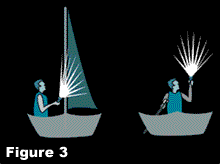
Power-Driven Boats Less Than 39.4 ft. Long When Underway
If less than 39.4 ft. (12 meters) long, these boats must exhibit the lights as shown in the figure below. Remember, power-driven boats include sailboats operating under power. The required lights are:
- Red and green sidelights (combination or separate lights) visible from a distance of at least one mile
- An all-round white light (sternlight) that is visible from all directions (360-degree visibility).
- The all-round white light (sternlight) must be at least 3.3 ft. (1 Meter) higher than the sidelights.

All Boats When Not Underway: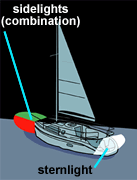
All boats are required to display a white light visible from all directions (360-degree visibility) whenever they are moored or anchored away from dock between sunset and sunrise.
Do you ride a personal watercraft? (Jet Ski, Waverunner, Sea-Doo, Etc.)
If so, listed are laws and regulations you should know:
- All operators, passengers or persons being towed must wear a U.S. Coast Guard-approved wearable life jacket. (Violation results in a minimum $100 fine plus court costs.)
- Unless your personal watercraft has the self-circling feature, you must have a lanyard-type emergency cut-off switch (ECOS) attached to the operator. (Violation results in a minimum $100 fine plus court costs.)
- No person under the age of 12 may operate a personal watercraft. Must be 14 years old and have a vessel license in possession to operate a vessel or personal watercraft alone. Operators 12 or 13 years old, after obtaining the vessel operator's license, can only operate if there is someone 21 years old or older on board, who also has a vessel operator's license in possession, and is seated in a position to take immediate control of the vessel if necessary. (Violation results in a minimum $100 fine plus court costs.)
- No person shall maneuver a personal watercraft in a manner which endangers life, limb, or property. (Violation results in a minimum fine of $150 plus court costs.)
- Examples:
- Weaving through congested vessel traffic at high speed.
- Following closely behind within the wake of a vessel towing a person or persons on water skis, surfboards, or other water sports devices.
- Jumping the wake of another vessel traveling in the same direction in close proximity to the vessel.
- Cutting between a boat and the person or persons being towed by that boat.
- Crossing at right angles in close proximity to the stern of another vessel, or when visibility around the other vessel is obstructed.
- Steering a personal watercraft toward any object or person in the water and turning sharply at close range so as to spray the object or person.
- Examples:
- All personal watercraft used for towing any person shall be equipped with rearview mirrors. The mirrors must contain a minimum viewing area size of ten (10) square inches. Each mirror must have a minimum viewing area height of 2.5 inches and a minimum viewing area width of 4 inches. The mirrors must be attached or mounted on both the right and left sides of the personal watercraft so as to provide the maximum rearward observation by the operator. Mirrors shall not be mounted on the steering mechanism of the personal watercraft. The minimum combined viewing area of both mirrors shall be twenty (20) square inches. NOTE: An observer is not accepted in lieu of mirrors. (Violation results in a minimum $100 fine plus court costs.)
- All personal watercraft operators must comply with the waterway “Rules of the Road”. (Violation results in a minimum $50 fine plus court costs.)
This is not a complete listing of all laws and regulations. Additional information can be obtained by contacting the Alabama Marine Patrol Division, Education/Operator Certification Section, 301 S. Ripley Street, Montgomery, AL 36104; (334) 676-7216.
Personal Flotation Devices (PFDs)
New federally mandated labeling of wearable PFDs may be found on newer personal flotation devices. The new labeling will show a performance level icon, such as 50, 70, 100 or 150. These are approved for the U.S. and Canada, whereas devices with the old labels (Type I - V) continue to be approved for one country or the other, not both.
The lower-level number offers more mobility, comfort, and style with good flotation, and is intended for near-shore (calm water) activities.
- Higher-level number offers greater flotation, turning, and stability in the water, and for offshore activities (greater time to rescue).
- When selecting your wearable PFD be honest about your swimming ability. Poor swimmers may need a higher level to stay upright and easily tread water.
Older wearable PFDs, such as the "Type I - V" are still acceptable as long as they are in good condition and appropriate for the activity.
All boats must be equipped with U. S. Coast Guard-approved wearable life jackets called personal flotation devices or PFDs. One wearable PFD is required for each person on board and/or being towed. Each wearable PFD must be in good condition, the proper size for the intended wearer and, very importantly, must be readily accessible! Readily accessible means you must be able to put the PFD on in a reasonable amount of time in an emergency (boat sinking, on fire, etc.). PFDs should not be stowed in plastic bags, in locked or closed compartments, or have other gear stowed on top of them.
Boat operators should ask everyone on their boat to wear a PFD whenever on the water. PFDs can save lives, but only if they are worn!
PFD Descriptions:
TYPE I: Offshore Life Jackets 
These vests are geared for rough or remote waters where rescue may take a while. They are excellent for flotation and will turn most unconscious persons face-up in the water.
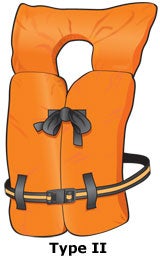 TYPE II: Near-Shore Vests
TYPE II: Near-Shore Vests
These vests are good for calm waters and fast rescues. Type II vests may lack the capacity to turn unconscious wearers face up.
TYPE III: Flotation Aids
- These vests or full-sleeved jackets are good for calm waters and fast rescues. They are not for rough waters since they will not turn a person face up. Some Type III PFDs are designed to inflate when you enter the water.
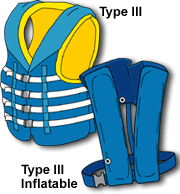
TYPE IV: Throwable Devices
Every vessel 16 ft. and longer must have on board one Throwable PFD (Type 4)
- These cushions or ring buoys are designed to be thrown to someone in trouble. They are not for long hours in rough waters, non-swimmers or the unconscious. A Throwable PFD (Type 4) will have a U.S. Coast Guard Approval label.

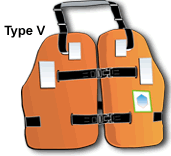 TYPE V: Special-Use Devices
TYPE V: Special-Use Devices
These windsurfing vests, deck suits, hybrid PFDs, and others are designed for specific activities, such as kayaking or water skiing. Some Type V wearable PFDs are designed to inflate when you enter the water. Inflatable Type V wearable PFDs must be worn when underway to be acceptable.
PFD Requirements:
- All boats must carry one wearable "Performance Level" 50, 70, 100 or 150 PFD or Type I, II, III, or V U. S. Coast Guard-approved PFD for each person onboard or being towed. If a Type V PFD is used, it must be approved for the activity at hand.
- All wearable PFDs must be in good and serviceable condition and be readily accessible. The PFDs must be of the proper size for the intended wearer. Sizing for PFDs is based on body weight and chest size.
- In addition to the above requirements, boats 16 ft. in length or longer must have one Throwable PFD (Type IV) U. S. Coast Guard-approved PFD onboard and readily accessible.
- Children under 8 years of age must wear a properly secured U. S. Coast Guard-approved PFD at all times while onboard any boat, except when in an enclosed cabin.
- Each person onboard a personal watercraft must wear a properly secured U. S. Coast Guard-approved wearable PFD.
- Each person being towed behind a boat or PWC must wear a properly secured U. S. Coast Guard-approved PFD.
- Each person onboard a boat within 800 feet below a hydroelectric dam and/or navigational lock and dam must wear a "Performance Level" 50, 70, 100 or 150 wearable PFD or Type I, II, III, or V U. S. Coast Guard-approved wearable PFD.
The text and graphics on this page are used by permission. Copyright © 2007 Boat Ed.
